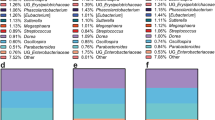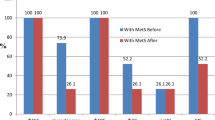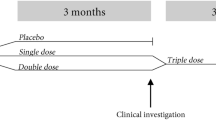Abstract
Objective:
We hypothesized that a dietary combination of soy with either a probiotic (yoghurt) or a prebiotic (resistant starch) would result in enhanced lipid-lowering effects compared with a control soy diet, possibly via improvements in isoflavone bioavailability.
Subjects:
Mildly hypercholesterolaemic subjects (men and post-menopausal women) older than 45 years were recruited via the local media. Thirty-six subjects commenced the study; five withdrew.
Results:
Soy+probiotic significantly decreased total cholesterol (4.7±2.0%; P=0.038) and soy+prebiotic significantly decreased total and low-density lipoprotein cholesterol (5.5±1.6%; P=0.003 and 7.3±2.2%; P=0.005, respectively). The bioavailabilities of daidzein, genistein or equol were not affected by probiotic or prebiotic consumption or associated with lipid changes.
Conclusion:
Dietary combination of soy with either a probiotic or a prebiotic resulted in significant lipid lowering, not related to isoflavone bioavailability.
This is a preview of subscription content, access via your institution
Access options
Subscribe to this journal
Receive 12 print issues and online access
$259.00 per year
only $21.58 per issue
Buy this article
- Purchase on Springer Link
- Instant access to full article PDF
Prices may be subject to local taxes which are calculated during checkout

Similar content being viewed by others

References
Adlercreutz H (1998). Evolution, nutrition, intestinal microflora, and prevention of cancer: a hypothesis. Proc Soc Exp Biol Med 217, 241–246.
Agerbaek M, Gerdes L, Richelson B (1995). Hypocholesterolaemic effect of a new fermented milk product in healthy middle-aged men. Eur J Clin Nutr 49, 346–352.
Agerholm-Larsen L, Bell M, Grunwald G, Astrup A (2000a). The effect of a probiotic milk product on plasma cholesterol: a meta-analysis of short-term intervention studies. Eur J Clin Nutr 54, 856–860.
Agerholm-Larsen L, Raben A, Haulrik N, Hansen A, Manders M, Astrup A (2000b). Effect of 8 week intake of probiotic milk products on risk factors for cardiovascular diseases. Eur J Clin Nutr 54, 288–297.
Anderson J, Johnstone B, Cook-Newell M (1995). Meta-analysis of the effects of soy protein intake on serum lipids. N Engl J Med 333, 276–282.
Brown I (1996). Complex carbohydrates and resistant starch. Nutr Rev 54, S115–S119.
Brown I, Wang X, Conway P (1999). Sticky and selective starches. Microbiol Aust 9, 18–19.
Brown I, Wang X, Topping D, Playne M, Conway P (1998). High amylose maize starch as a versatile prebiotic for use with probiotic bacteria. Food Aust 50, 602–609.
Crouse J, Morgan T, Terry J, Ellis J, Vitolins M, Burke G (1999). A randomized trial comparing the effect of casein with that of soy protein containing varying amounts of isoflavones on plasma concentration of lipids and lipoproteins. Arch Intern Med 59, 2070–2076.
Cummings J, Roberfroid M, Andersson H, Barth C, Ferro-Luzzi A, Ghoos Y et al. (1997). A new look at dietary carbohydrate: chemistry, physiology and health. Eur J Clin Nutr 51, 417–423.
Friedewald W, Levy R, Fredickson D (1972). Estimation of the concentration of LDL cholesterol in plasma without the use of the preparative ultracentrifuge. Clin Chem 18, 499–502.
Gamache PH, Acworth IN (1998). Analysis of phytoestrogens and polyphenols in plasma, tissue, and urine using HPLC with coulometric array detection. Proc Soc Exp Biol Med 217, 274–280.
Gibson G (1998). Dietary modulation of the human gut microflora using prebiotics. Br J Nutr 80, S209–S212.
Gibson G (1999). Dietary modulation of the human gut microflora using the prebiotics oligofructose and inulin. J Nutr 129, S1438–S1441.
Gomes A, Malcata F (1999). Bifidobacterium spp. and Lactobacillus acidophilus: biological, biochemical, technological and therapeutical properties relevant for use as probiotics. Trends Food Sci Tech 10, 139–157.
Greany K, Nettleton J, KE W, Thomas W, Kurzer M (2004). Probiotic consumption does not enhance the cholesterol-lowering effect of soy in postmenopausal women. J Nutr 134, 3277–3283.
Harland J, Carr T (2004). Does a practical daily intake of ∼25 g soy protein significantly lower cholesterol? A meta-analysis of recent studies. J Nutr 134, S1267.
Hentges D (1980). Does diet influence human fecal microflora composition. Nutr Rev 38, 329–336.
Hodgson J, Puddey I, Beilin L, Mori T, Croft K (1998). Supplementation with isoflavonoid phytoestrogens does not alter serum lipid concentrations: a randomized controlled trial in humans. J Nutr 128, 728–732.
Hoebler C, Karinthi A, Chiron H, Champ M, Barry J (1999). Bioavailability of starch in bread rich in amylose: metabolic responses in healthy subjects and starch structure. Eur J Clin Nutr 53, 360–366.
Jenkins D, Vuksan V, Rao A, Vidgen E, Kendall C, Tariq N et al. (1999). Colonic bacterial activity and serum lipid risk factors for cardiovascular disease. Metabolism 48, 264–268.
Larkin TA . Soy isoflavone bioavailability: effects of probiotic and prebiotic consumption and oil supplementation. PhD Thesis, University of Wollongong: Australia, 2005.
Lichtenstein A (1998). Soy protein, isoflavones and cardiovascular disease risk. J Nutr 128, 1589–1592.
Merz-Demlow B, Duncan A, Wangen K, Xu X, Carr T, Phipps W et al. (2000). Soy isoflavones improve plasma lipids in normocholesterolemic, premenopausal women. Am J Clin Nutr 71, 1462–1469.
Muir J, Walker K, Kaimakamis M, Cameron M, Govers M, Lu Z et al. (1998). Modulation of fecal markers relevant to colon cancer risk: a high-starch Chinese diet did not generate expected beneficial changes relative to a Western-type diet. Am J Clin Nutr 68, 372–379.
Nestel P, Yamashita T, Sasahara T, Pomeroy S, Dart A, Komesaroff P et al. (1997). Soy isoflavones improve systemic arterial compliance but not plasma lipids in menopausal and perimenopausal women. Arterioscler Thromb Vasc Biol 17, 3392–3398.
O'Sullivan D (2001). Screening of intestinal microflora for effective probiotic bacteria. J Agric Food Chem 49, 1751–1760.
Parodi P (1999). The role of intestinal bacteria in the causation and prevention of cancer: modulation by diet and probiotics. Aust J Dairy Tech 54, 103–121.
Pereira D, Gibson G (2002). Effects of consumption of probiotics and prebiotics on serum lipid levels in humans. Crit Rev Biochem Mol Biol 37, 259–281.
Potter S (1998). Soy protein and cardiovascular disease: the impact of bioactive components in soy. Nutr Rev 56, 231–235.
Richelson B, Kristensen K, Pedersen S (1996). Long-term (6 months) effect of a new fermented milk product on the level of plasma lipoproteins—a placebo-controlled and double blind study. Eur J Clin Nutr 50, 811–815.
Rowland I (1999). Optimal nutrition: fibre and phytochemicals. Proc Nutr Soc 58, 415–419.
Rowland I, Wiseman H, Sanders T, Adlercreutz H, Bowey E (1999). Metabolism of oestrogens and phytoestrogens: role of the gut microflora. Biochem Soc Trans 27, 304–308.
Sanders M (2000). Considerations for use of probiotic bacteria to modulate human health. J Nutr 130, S384–S390.
Schaafsma G, Meuling W, van Dokkum W, Bouley C (1998). Effect of a milk product, fermented by Lactobacillus acidophilus and with fructo-oligosaccharides added, on blood lipids in male volunteers. Eur J Clin Nutr 52, 436–440.
Silvi S, Cresci R, Rowland I (1999). Resistant starch modifies gut microflora and microbial metabolism in human flora-associated rats inoculated with faeces from Italian and UK donors. J Appl Microbiol 86, 521–530.
Steinberg F, Guthrie N, Villablanca A, Kumar K, Murray M (2003). Soy protein with isoflavones has favorable effects on endothelial function that are independent of lipid and antioxidant effects in healthy postmenopausal women. Am J Clin Nutr 78, 123–130.
Taylor G, Williams C (1998). Effects of probiotics and prebiotics on blood lipids. Br J Nutr 80, S225–S230.
Topping D, Clifton P (2001). Short-chain fatty acids and human colonic function: roles of resistant starch and nonstarch polysaccharides. Physiol Rev 81, 1031–1064.
Turner N, Thomson B, Shaw I (2003). Bioactive isoflavones in functional foods: the importance of gut microflora on bioavailability. Nutr Rev 61, 204–213.
Wangen K, Duncan A, Xu X, Kurzer M (2001). Soy isoflavones improve plasma lipids in normocholesterolemic and mildly hypercholesterolemic postmenopausal women. Am J Clin Nutr 73, 225–231.
Warnick G, Benderson J, Albers J (1982). Dextran sulfate-Mg2+ precipitation procedure for quantitation of high-density lipoprotein cholesterol. Clin Chem 28, 1379–1388.
Weggemans R, Trautwein E (2003). Relation between soy-associated isoflavones and LDL and HDL cholesterol concentrations in humans: a meta-analysis. Eur J Clin Nutr 57, 940–946.
Winter J, Bokkenheuser V (1987). Bacterial metabolism of natural and synthetic sex hormones undergoing enterohepatic circulation. J Steroid Biochem 27, 1145–1149.
Xiao J, Kondo S, Takahashi N, Miyaki K, Oshida K, Hiramatsu A et al. (2003). Effects of milk products fermented by Bifidobacterium longum on blood lipids in rats and healthy adult male volunteers. J Dairy Sci 86, 2452–2461.
Yeung J, Yu T (2003). Effects of isoflavones (soy phyto-estrogens) on serum lipids: a meta-analysis of randomised controlled trials. Nutr J 2, 1.
Acknowledgements
We acknowledge financial support from The Australian Research Council, Specialty Cereals Pty Ltd and the ARC Smart Foods Key Centre at the University of Wollongong. The following companies provided foods for the dietary interventions: Specialty Cereals Pty Ltd, Mt Kuring-gai, New South Wales, Australia; So Natural Foods, Taren Point, New South Wales, Australia; Vaalia, Pauls Dairy, Brisbane, Qld, Australia; Penford Australia Ltd, Sydney, New South Wales, Australia.
Author information
Authors and Affiliations
Corresponding author
Rights and permissions
About this article
Cite this article
Larkin, T., Astheimer, L. & Price, W. Dietary combination of soy with a probiotic or prebiotic food significantly reduces total and LDL cholesterol in mildly hypercholesterolaemic subjects. Eur J Clin Nutr 63, 238–245 (2009). https://doi.org/10.1038/sj.ejcn.1602910
Received:
Revised:
Accepted:
Published:
Issue Date:
DOI: https://doi.org/10.1038/sj.ejcn.1602910
Keywords
This article is cited by
-
Effects of Probiotic Enterococcus faecium from Yak on the Intestinal Microflora and Metabolomics of Mice with Salmonella Infection
Probiotics and Antimicrobial Proteins (2023)
-
Recent Innovations in Non-dairy Prebiotics and Probiotics: Physiological Potential, Applications, and Characterization
Probiotics and Antimicrobial Proteins (2023)
-
Nutraceutical approach for the management of cardiovascular risk – a combination containing the probiotic Bifidobacterium longum BB536 and red yeast rice extract: results from a randomized, double-blind, placebo-controlled study
Nutrition Journal (2019)
-
Effects of products designed to modulate the gut microbiota on hyperlipidaemia
European Journal of Nutrition (2019)
-
The effect of Lactobacillus rhamnosus hsryfm 1301 on the intestinal microbiota of a hyperlipidemic rat model
BMC Complementary and Alternative Medicine (2014)


